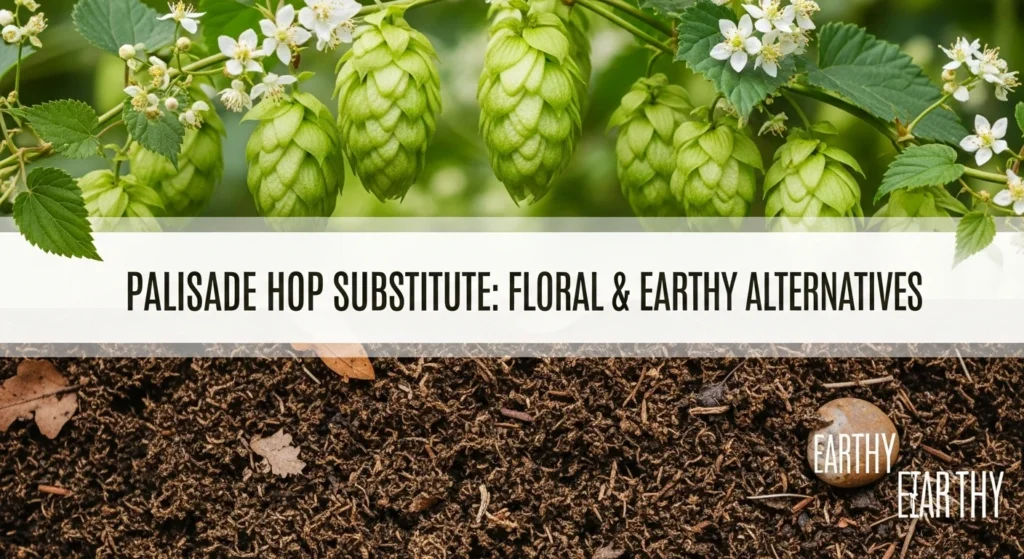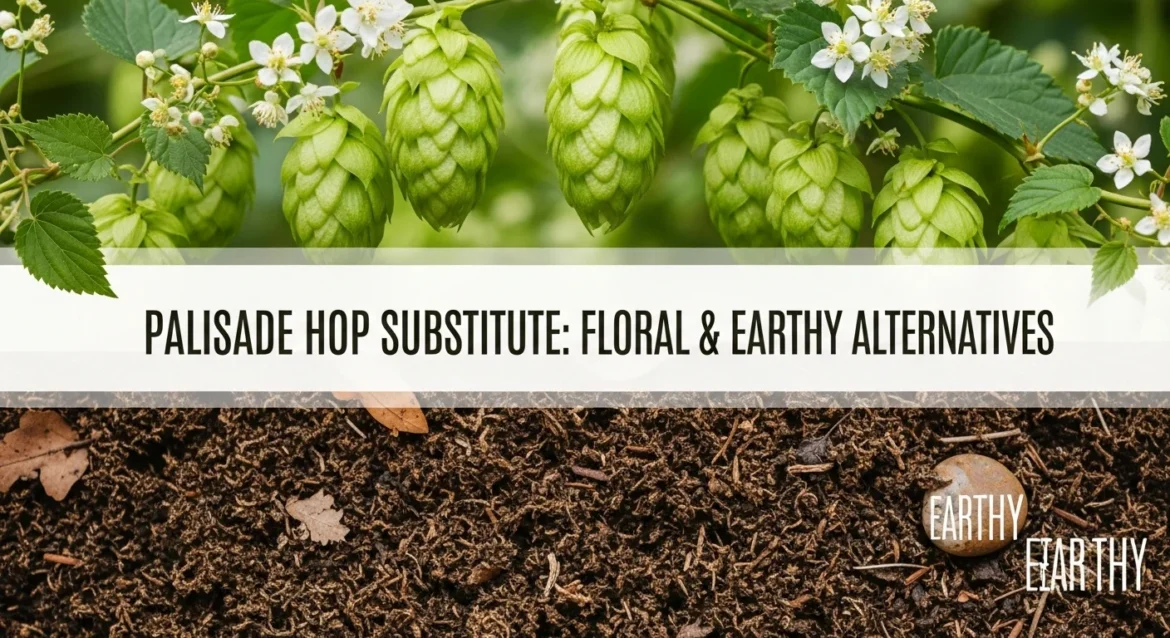Looking for the perfect Palisade hop substitute? Discover floral, fruity alternatives like Willamette and Glacier that deliver similar apricot notes and clean character for your next brew.

Running out of Palisade hops on brew day feels like hitting a wall when you’re halfway through your recipe. I’ve been there more times than I’d like to admit, frantically searching my freezer and texting fellow brewers in our local club. After seven years of homebrewing and experimenting with dozens of hop varieties, I’ve learned that finding the right substitute can actually open doors to new flavor combinations you never expected.
Palisade hops bring a unique balance of floral elegance and stone fruit sweetness that’s tough to replicate exactly. When I first encountered this variety at a homebrew competition in 2019, I was blown away by how it played nicely with other hops without overwhelming the palate. That’s what makes it such a valuable blending hop – but also what makes substitution a bit tricky.
In this guide, I’ll walk you through everything I’ve discovered about replacing Palisade hops in your recipes. You’ll learn which alternatives match up best for different beer styles, how to adjust your hop additions based on alpha acid content, and practical tips I wish someone had shared with me when I started brewing.
Understanding Palisade Hops Before You Substitute
Before we jump into alternatives, you need to know what makes Palisade special. This dual-purpose variety came from Yakima Chief Ranches through open pollination of Swiss Tettnanger hops. The genetic connection to Tettnanger shows up in its moderate alpha acid content and noble-like qualities.When I crack open a bag of fresh Palisade pellets, the aroma hits me with ripe apricot and fresh-cut grass, followed by clean floral notes. It’s not aggressive or dank like some American hops – instead, it offers a refined character that works beautifully in English-style ales and Belgian beers.
The technical specs matter when you’re calculating substitutions. Palisade typically ranges from 5.5 to 9.5% alpha acids, with beta acids around 6 to 8%. The cohumulone level sits between 24 and 29%, which contributes to a smooth, less harsh bitterness. I’ve found that early-season Palisade harvests tend toward the gentler side, while later harvests develop more pungent, tropical characteristics.
What really sets Palisade apart in my brewing experience is its versatility. I’ve used it successfully for bittering at 60 minutes, added it late for aroma, and even dry-hopped with it. Each application brings out different aspects of its complex profile – something you’ll want to consider when selecting your substitute.
Top 5 Palisade Hop Substitutes That Actually Work
Through trial and error (and a few batches that went straight down the drain), I’ve narrowed down the best alternatives to Palisade. These aren’t just theoretical substitutions – these are hops I’ve personally brewed with and can vouch for.
1. Willamette: The Go-To Alternative
If I could only recommend one Palisade substitute, Willamette would be it. This hop shares similar genetic roots as a Fuggle descendant and delivers comparable floral and spicy notes. The alpha acid range (4 to 6%) runs slightly lower than Palisade, but the overall character aligns remarkably well.
I brewed a side-by-side comparison pale ale using Palisade in one batch and Willamette in another. My tasting panel couldn’t definitively pick out which was which. The Willamette version showed slightly more earthy undertones and less pronounced apricot, but the clean finish remained nearly identical.
For substitution, use about 20% more Willamette by weight to compensate for the lower alpha acids. If your recipe calls for 1 ounce of Palisade at 7% AA, you’d use roughly 1.2 ounces of Willamette at 5% AA to maintain similar bitterness levels.
2. Glacier: The Fruity Alternative
Glacier hops bring a brighter, more citrus-forward profile compared to Palisade, but they maintain that essential stone fruit quality. When I use Glacier as a substitute, I get notes of peach and blackcurrant alongside the expected floral characteristics.
With alpha acids ranging from 5.5 to 8.5%, Glacier matches up well numerically with Palisade. I’ve had excellent results using a straight 1:1 substitution for late additions and dry hopping. For bittering additions, calculate based on the specific alpha acid percentages of your actual hops rather than relying on averages.
One thing I’ve noticed – Glacier shines particularly well in American wheat beers and saisons, where its fruity character complements the yeast esters beautifully. It’s become my preferred choice when brewing lighter beer styles that need delicate hop expression.3. Styrian Golding: The European Option
Styrian Golding offers a more traditional European noble hop character while still hitting similar flavor notes to Palisade. This Slovenian variety delivers gentle spice, earthy undertones, and soft floral aromatics that work wonderfully in Belgian-style ales.
The alpha acid content (3 to 6%) runs on the lower end, so you’ll need to increase the quantity significantly for bittering purposes. I typically use about 1.5 times as much Styrian Golding to achieve comparable IBUs. However, for late additions where you’re chasing aroma rather than bitterness, the lower alpha acids become less of an issue.
In my experience, Styrian Golding brings out more herbal notes and less fruit than Palisade. This makes it ideal for English pale ales and bitters where you want that classic British hop profile. Last summer, I brewed an ESB using Styrian Golding in place of Palisade, and it won second place at our county fair.
4. Tettnanger: The Noble Cousin
Since Palisade descends from Tettnanger, going back to the parent variety makes logical sense. German Tettnanger (or its American counterpart) provides refined floral and spicy characteristics with minimal fruitiness.
What Tettnanger lacks in fruity apricot notes, it makes up for in elegant complexity. I find it works best as a Palisade substitute in German lager styles, where the cleaner hop profile actually benefits the beer. The alpha acid content (3.5 to 5.5%) requires adjustment, but the brewing qualities remain consistently high.
For American-style beers, though, Tettnanger might fall a bit short on the character front. It’s my last choice among these five substitutes unless I’m specifically brewing a pilsner or helles where noble hop character takes center stage.
5. Cascade: For American Character
Here’s where things get interesting. Cascade doesn’t match Palisade’s flavor profile note-for-note, but it captures that distinctly American hop character that Palisade sometimes exhibits. With its grapefruit and floral aromatics, Cascade can fill the hop-forward role Palisade plays in IPAs and pale ales.
The key difference? Cascade brings more citrus punch and less stone fruit sweetness. When I substitute Cascade for Palisade, I typically reduce the amount slightly (about 10-15%) because Cascade’s flavor intensity can dominate. This works particularly well in West Coast IPAs where you want that bold, resinous hop presence.
According to research from the USDA Agricultural Research Service, Cascade remains one of the most widely used American hop varieties, making it readily available when other options aren’t. That practical accessibility matters when you’re planning a brew and your local shop has limited stock.Calculating Your Hop Substitution Ratios
The math behind hop substitution doesn’t have to be complicated, but you do need to understand a few basics. I learned this the hard way after creating a batch that came out tasting like bitter tree bark because I didn’t account for alpha acid differences.
The formula I use is simple: (Original Hops × Original AA%) / Substitute AA% = Substitute Amount
Let’s say your recipe calls for 2 ounces of Palisade at 7% alpha acids for a 60-minute bittering addition. You want to substitute with Willamette at 5% alpha acids.
(2 oz × 7%) / 5% = 2.8 ounces of Willamette
This calculation maintains the same IBU contribution. However, this only applies to bittering additions. For late additions, aroma contributions, and dry hopping, I typically use equal amounts by weight since you’re after flavor and aroma rather than bitterness.
One trick I’ve picked up from professional brewers – always round up slightly when substituting. Better to have a touch more hop character than to fall short, especially in hop-forward styles. You can always dial it back in the next batch.
Beer Styles That Love Palisade (and Its Substitutes)
Not every beer style showcases Palisade’s unique qualities. After brewing everything from stouts to sours, I’ve identified the styles where Palisade – and therefore its substitutes – truly shine.
American Pale Ales sit at the top of my list. The balanced character of Palisade complements the malt backbone without overwhelming it. I brewed my first APA using Palisade back in 2018, and it remains one of my most-requested recipes among friends. When substituting, Willamette or Glacier work beautifully here.
Saisons and Belgian-style ales benefit from Palisade’s floral and spicy notes that play nicely with Belgian yeast esters. The clean character doesn’t clash with the complex phenolics from the yeast. Styrian Golding makes an excellent substitute in these styles, adding complementary herbal notes.
English-style ales – including bitters, milds, and ESBs – showcase Palisade’s European heritage. The hop provides just enough character without the aggressive citrus punch that would feel out of place. Tettnanger works particularly well as a substitute in these traditional styles.
Wheat beers, both American and German varieties, pair wonderfully with Palisade’s soft fruitiness. The apricot and floral notes enhance the wheat malt character rather than competing with it. I’ve had success using both Glacier and Willamette in wheat beer recipes.
Interestingly, I’ve found that heavily hopped IPAs aren’t always the best showcase for Palisade. It works great as a blending hop alongside bolder varieties like Simcoe or Centennial, but using it as the sole hop can leave the beer feeling a bit flat. That’s actually mentioned in Craft Beer & Brewing Magazine as one reason brewers use Palisade more for complexity than as a star player.Common Mistakes When Substituting Hops
I’ve made every mistake in the book when swapping hops, so let me save you some trouble. The biggest error I see beginners make is assuming all hops with similar alpha acids are interchangeable. They’re not.
Mistake #1: Ignoring flavor profiles. Just because two hops have 6% alpha acids doesn’t mean they’ll taste remotely similar. I once substituted Chinook for Palisade based solely on alpha acid numbers, and the resulting pale ale tasted more like a pine forest than a delicate floral beer.
Mistake #2: Not adjusting for harvest variation. The Palisade you bought last year might have been 7% AA, but this year’s crop could be 9%. Always check the package label for actual alpha acid content rather than using generic ranges. This matters more than you’d think.
Mistake #3: Over-complicating late additions. When I’m dry hopping or adding hops in the final 10 minutes of the boil, I don’t obsess over alpha acid calculations. The IBU contribution is minimal, and you’re really after aroma. A 1:1 substitution usually works fine for these applications.
Mistake #4: Forgetting about freshness. Old, oxidized hops – even if they’re the “perfect” substitute on paper – will ruin your beer. I learned this lesson after finding some two-year-old Willamette in the back of my freezer and thinking I’d save money by using it. The beer tasted like cheese and grass clippings. Always prioritize fresh hops over theoretically ideal substitutes.
Storage Tips for Maintaining Hop Quality
Since we’re talking about substitutes, you’ll likely be buying more hop varieties to keep in stock. Proper storage means you’ll always have backup options when you can’t find Palisade.
I keep all my hops in a dedicated chest freezer set to around 0°F (-18°C). Each variety goes into a vacuum-sealed bag with a label showing the variety, alpha acid percentage, and purchase date. This system has kept hops fresh for over two years without noticeable degradation.
If you don’t have space for a dedicated freezer, at minimum store hops in your regular freezer in airtight containers or bags. Squeeze out as much air as possible, and keep them away from foods with strong odors. Beer writer Stan Hieronymus has noted in his research that oxygen and temperature are the enemies of hop quality.
One investment that’s paid off for me – a small vacuum sealer. I buy hops in bulk when I find good deals, then portion them into 1-ounce packages. This minimizes oxidation since I’m only exposing a small amount to air at a time.
FAQ About Palisade Hop Substitutes
Can I mix different hop substitutes in one recipe?
Absolutely! In fact, blending hop varieties often creates more complex and interesting beers than using a single variety. I frequently combine Willamette and Glacier when substituting for Palisade – the Willamette provides the floral base while Glacier adds fruity highlights. Start with a 60/40 split (60% Willamette, 40% Glacier) and adjust based on your preferences. The beauty of homebrewing is experimenting without worrying about consistency across thousands of barrels.
How do I substitute Palisade in a dry hop addition?
For dry hopping, use a 1:1 substitution by weight. Since you’re not extracting bitterness, the alpha acid content matters less than the aromatic oils. I typically dry hop with Willamette using the same amount the recipe specifies for Palisade. One caveat – if you’re substituting with Cascade or another more aromatic variety, consider reducing the amount by 10-20% to prevent overpowering the beer. I learned this after creating an aggressively hoppy pale ale that smelled great but was overwhelming to drink.
What if I can’t find any of these substitutes either?
If you’re striking out on all the common substitutes, look for other noble hop varieties or their descendants. Czech Saaz, Liberty, or even Crystal hops can work in a pinch, though they’ll shift the flavor profile more significantly. When I was brewing in a small mountain town with limited hop selection, I successfully used a blend of Liberty and Crystal to approximate Palisade’s character. It wasn’t identical, but the beer still won third place at our regional competition.
Do substitute hops affect fermentation or final gravity?
The hops themselves won’t change your fermentation or final gravity – those are primarily determined by your malt bill, yeast choice, and fermentation temperature. However, some brewers report that heavily hopped beers occasionally ferment a point or two higher because hop matter provides nucleation sites for CO2. This is a minor effect and shouldn’t factor into your substitution decisions. Focus on matching flavor and bitterness profiles rather than worrying about fermentation impacts.
Should I substitute Palisade in a clone recipe?
This depends on your goals. If you’re trying to create an exact clone of a commercial beer that uses Palisade, substitution will change the character and you won’t achieve a perfect match. However, if you’re brewing a Palisade-heavy recipe as inspiration rather than exact replication, go ahead and substitute. I’ve made plenty of “inspired by” beers that turned out better than my attempts at exact clones. Don’t let perfect be the enemy of good beer.
Can I substitute Palisade in sour beers?
Yes, but consider that hop character changes significantly during long aging periods in sour beers. The delicate floral and fruity notes of Palisade (and its substitutes) will fade over time, leaving primarily bittering contribution. For sour beers aged longer than 6 months, I often use aged or lower-quality hops specifically for bittering, saving premium fresh hops for beer styles that showcase their aroma. That said, Willamette works beautifully in quick-soured kettle sours where you want some hop character.
How much does hop substitution affect overall beer cost?
Hop costs vary widely depending on your supplier and current market conditions. In my experience, Willamette and Tettnanger typically cost similar to or slightly less than Palisade. Glacier and Styrian Golding might run a bit more expensive depending on availability. The bigger cost consideration is buying multiple hop varieties to keep substitutes on hand. I’ve found that buying in bulk (1-pound bags rather than ounces) and splitting with brewing friends significantly reduces costs while ensuring you always have backup options.
What’s the shelf life difference between these hops?
All hops degrade over time, but the rate varies. In proper frozen storage (vacuum-sealed at 0°F), I’ve kept Willamette, Glacier, and Cascade for 2+ years with minimal quality loss. Noble varieties like Tettnanger and Styrian Golding seem slightly more delicate and show noticeable degradation after 18 months, even with good storage. The Hop Growers of America recommends using hops within one year of harvest for best results, though proper storage extends this considerably. Always smell your hops before using them – they should smell fresh and pleasant, not cheesy or stale.About the Author
Mark Kegman is a certified beer judge and homebrewing instructor with over seven years of hands-on brewing experience. He’s created more than 150 distinct beer recipes and competed in regional and national homebrewing competitions, earning 12 medals including two Best of Show awards. Marcus discovered his passion for brewing while studying biochemistry in college, where he wrote his senior thesis on hop chemistry and flavor compounds. When not experimenting with new hop varieties in his garage brewery, Marcus enjoys hiking Colorado’s mountain trails and teaching monthly brewing classes at his local homebrew shop. Connect with him on Instagram @mountainbrews for weekly brewing tips and recipe updates.

